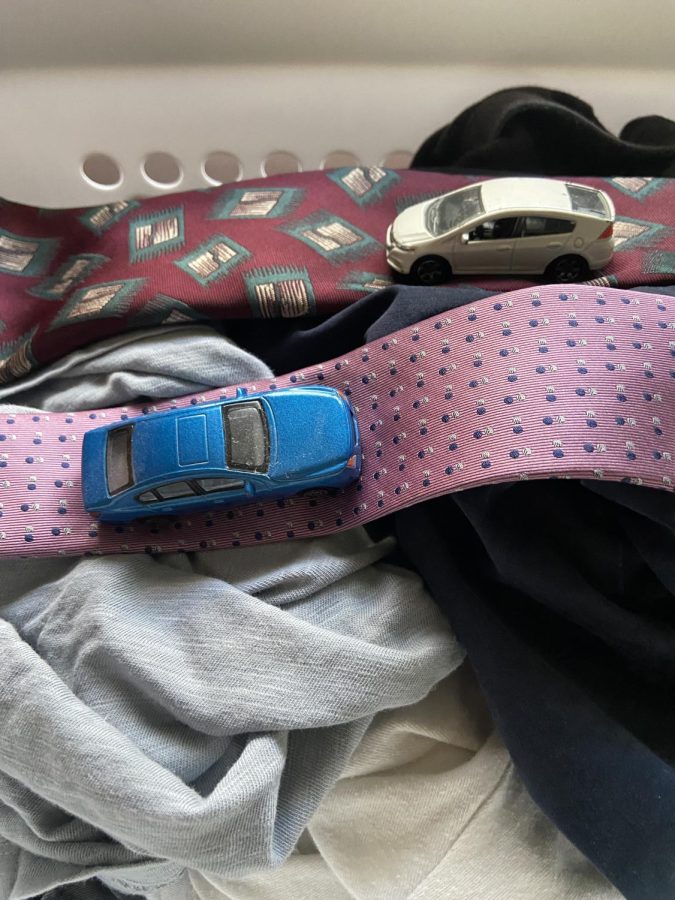The difficult road to sustainable fashion
Finding new clothes that are sustainable can be a difficult ordeal
An excellent metaphor for the difficulties of finding sustainable clothing.
April 7, 2023
LOS ALAMITOS, CA — In an era where the climate is warming and waste is rising, many of us want to reduce our impact on the environment. It is one thing to adapt diets and daily activities to meet the needs of the future. However, when we adjust our wardrobes, trying to be sustainable is an ordeal. Oftentimes, sustainable clothing is expensive and hard to come by. Furthermore, some claims about the ethical, environmental impact of clothing can be misleading, adding to the challenge. So, is there any way to save the planet and your wallet?
What makes clothing sustainable anyways?
Sustainable clothes can look like clothing from any other clothing manufacturer. No strange environmental activist patterns, no major compromises in material or durability, nothing that screams tree-hugger. A pair of sustainable jeans is the same as a pair of regular jeans with the environmental benefits being the only exception. However, according to Norwich University of the Arts, there are five facets to sustainable clothing: longevity, timelessness, materials, production, and knowledge.
Longevity is arguably the most important facet to sustainability in clothing. Investing in clothing that uses high-quality materials that will last for generations incentivizes people to keep their clothing for longer.
However, to ensure the longevity of clothing, designs also have to reflect a sense of timelessness. Instead of following ephemeral fashion trends, manufacturers and consumers must consider clothing that is not considered “fast-fashion,” clothing that is considered fashionable for a short amount of time and produced with disposable materials.
Materials and the production of clothing affect the sustainability of clothing as well. Recycling materials from old clothing or off-cuts (excess material after the production process) are necessary to reduce waste. Likewise, garment companies must regulate their production to guarantee that there is little to no surplus in their inventory.
The last facet of sustainability is knowledge. Understanding the clothes making process and its impact on the environment is crucial in knowing what to look for when shopping for environmentally ethical garments. This is especially important when identifying attempts at “greenwashing” (false claims of environmental ethics to lure more buyers). The most useful source to evaluate clothing sustainability comes from Good on You; it takes into account the effects of various brands’ impacts on environment, labor, and testing.
Challenges looking for sustainability
When conducting my research, I first looked for clothing that would suit me. It was hard not to deny that most sustainable brands I came across were geared specifically towards women. That is perfectly fine, but, as a man, it makes things a little difficult.
Furthermore, most of the brands that were marketed as sustainable, I have never heard of before, and, as a result, that makes these companies’ reputations unknown, begging the question on whether it is worth paying for the benefits of sustainability in the first place.
That brings cost into the orbit. Shoes from an unknown company for $150? A t-shirt from a strange Asian company with a triple digit price? Even for a fervent environmentalist like myself, these prices are bombastic. For people less interested in implementing sustainability into their lives, these prices are deal breakers, especially when factoring in the other complications of shopping specifically for sustainable clothes.
So, what did you like?
When doing research, these were the five sustainable clothing companies that stood out to me: Asket, Olderbrother, Nisolo, Cotopaxi, and Patagonia.
Asket – This Swedish company offers a variety of garments from coats to underwear. Asket sells neutral designs for both men and women. Out of all the companies in my research, Asket was the only one to offer belts, underwear, socks, and traditional business attire. Unlike some of the other sustainable options on the market, Asket is less conspicuous and more traditional. On Good on You, Asket is rated the second-highest rating, good.
Olderbrother – Specializing primarily in outerwear, Oldebrother offers unique, rustic styles. Much of this American clothing brand’s dying comes from the Japanese kakishibu technique that uses fruit to color clothing. Olderbrother produces its clothing in California, and On Good on You rates them as good.
Nisolo – Selling shoes and other accessories, Nisolo offers professional designs that elevate one’s appearance. The company offers both men’s and women’s options in varying styles and neutral colors. Nisolo has a five pillar sustainability framework that emphasizes people, planet, transparency, accountability, and collaboration. This American brand has a good rating from Good on You.
Cotopaxi – Founded in 2014, Cotopaxi is a newcomer in the competitive outdoorswear industry. However, the company has made its mark with its vivid color options and commitment to sustainability. Unlike other sustainable brands, Cotopaxi can be found at major retailers like R.E.I.. Good on You rates Cotopaxi good.
Patagonia – Arguably the most well-known brand in sustainable clothing, Patagonia is proof of corporate success whilst maintaining its eco-concious credentials. Over the years, I have owned multiple Patagonia products from jackets to backpacks, and they have never let me down. Patagonia also has a program where customers can trade-in used items that the outdoor wear company then sells on their Patagonia Worn Wear website. Additionally, customers can send Patagonia attire to be repaired by the company for no charge, adding to the longevity of their products. Good on You rates this outdoor wear company as good.
What are some more cost-effective alternatives?
The most obvious alternative to buying new sustainable clothing is to buy used clothing. Thrift stores, swap meets, and garage sales are all great options to look for your specific style and size. Compared to buying new clothing, it can take more time to find used items. When going to a thrift store, they do not have multiple sizes like when shopping for new clothing. If a nice shirt or pair of jeans turns up at a swap meet and they do not fit, oh well, there are no other options. Of course, this can happen when shopping new, but usually stores also have a backlog.
For those not wanting to go to a physical location, there are online options, as well. The most well known online second hand vendor is Poshmark. There are similar shortcomings to Poshmark as there are to thrift stores, swap meets, and garage sales. However, this online retailer has the advantage of convenience. After all, what’s more convenient than shopping for clothes on your couch?
But, the best option of all is to simply keep clothes for a longer period of time. This can happen by purchasing more timeless designs and repairing clothes to keep them in use for longer.
Conclusion
Sustainble clothing is important for the future of the planet. According to Boston University, 34 billion clothes are thrown away each year in the United States. That equates to one American throwing 100 pounds of clothing per year. Therefore, it is paramount that consumers diligently shop for more sustainable options. However, that can be difficult, as a vast majority of eco-concious brands are niche and are not often sold at traditional stores like Nordstrom or Macy’s. However, by shopping for sustainable products, it reduces the demand for unsustainable options. This will then incentivize traditional companies to adopt the sustainable environmental practices of their competition.





